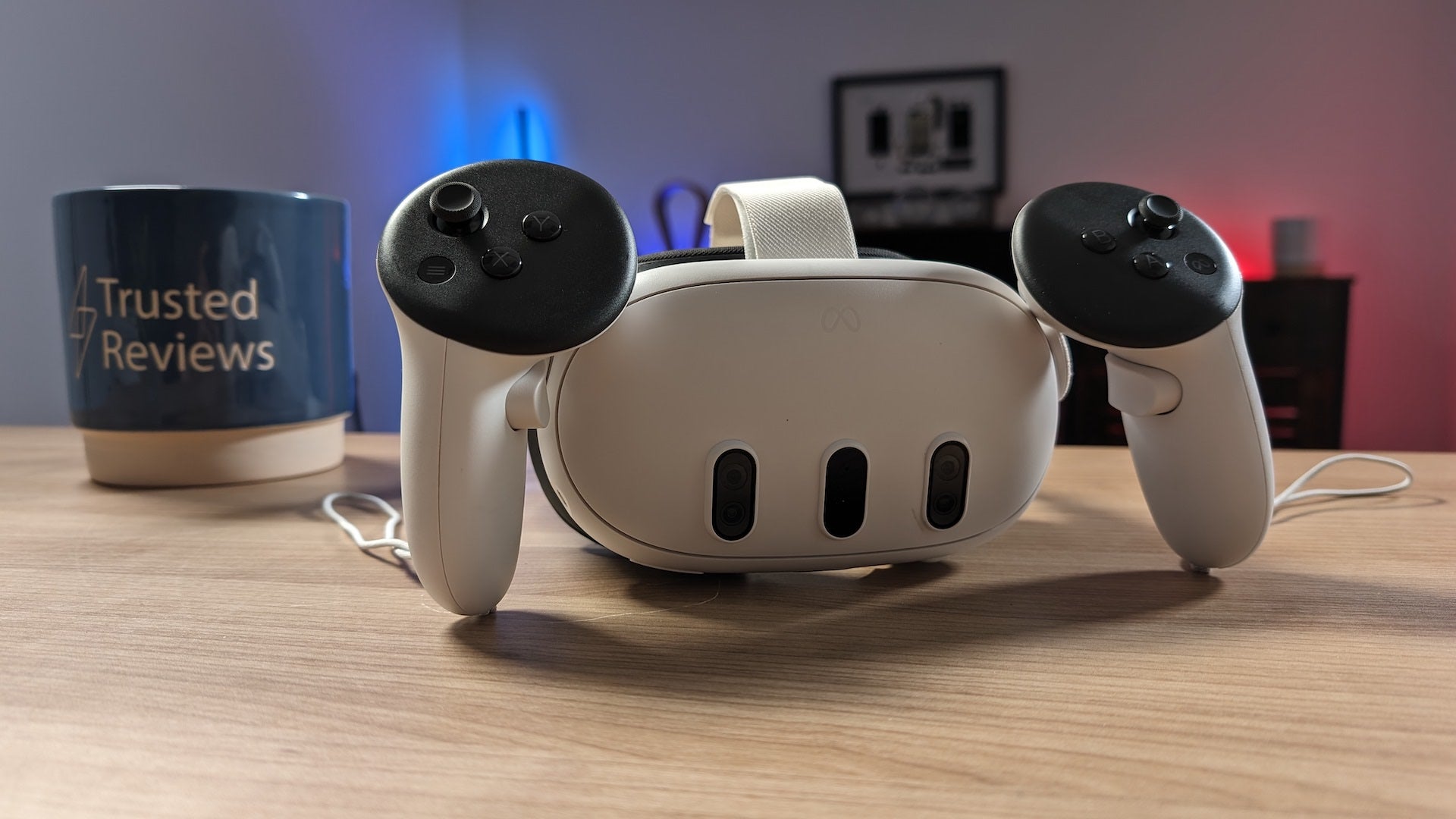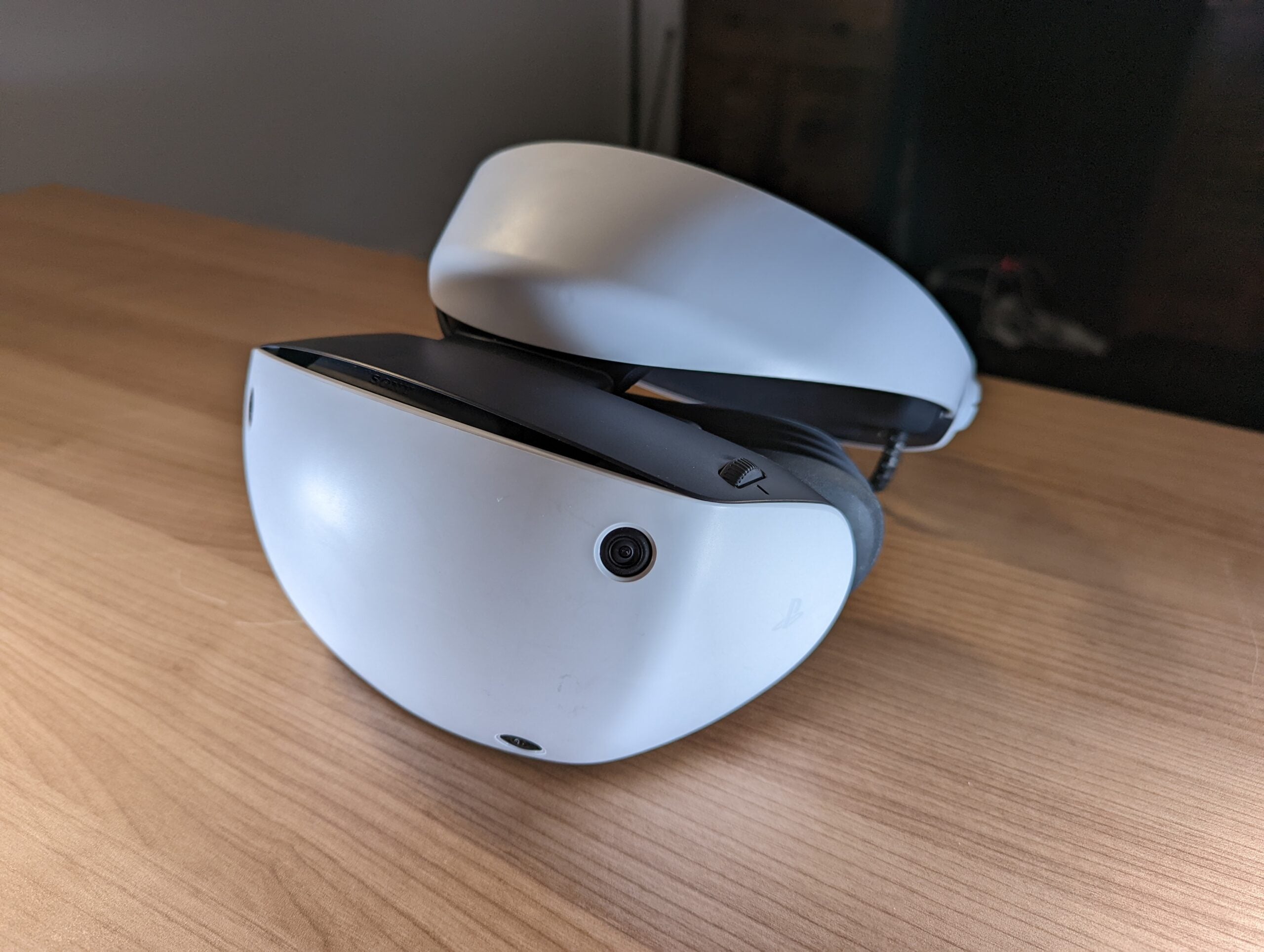Meta Quest Pro Review
A pricey, niche option with fascinating tech for early AR adopters


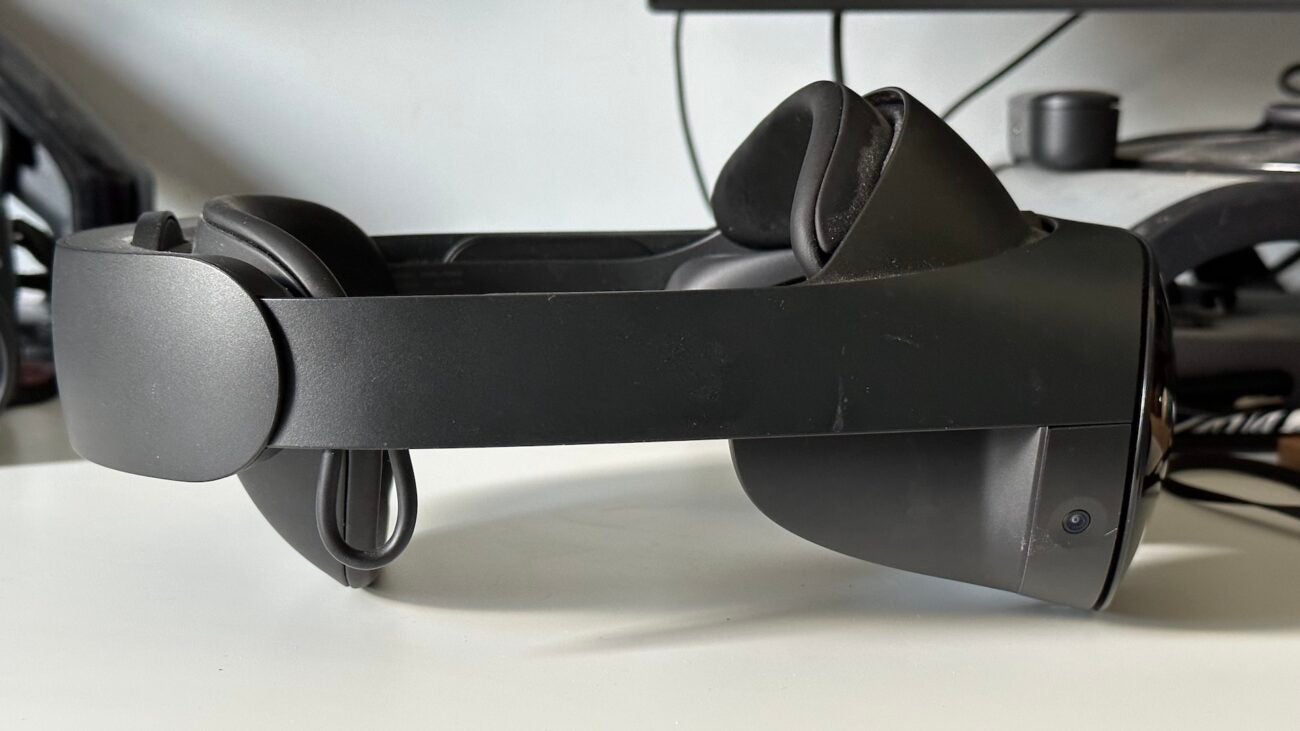







Verdict
The Meta Quest Pro offers impressive features like colour passthrough for AR, face- and eye-tracking and improved optics, but the lack of AR apps, the top-end price and the fact that colour AR is coming to the Quest 3 later this year at half the price means it has a very limited audience.
Pros
- Relatively thin, lightweight design
- Great visuals
- Improved tracking with Quest Pro controllers
- Face- and eye-tracking are a boon for social VR
Cons
- Lack of killer AR apps
- Can get uncomfortable over long periods of wear
- Limited battery life
Key Features
- Face- and eye-trackingThe Quest Pro will not only track your position in realtime, but your facial expressions and even your gaze, ideal for social VR apps.
- Colour passthrough ARColour passthrough allows for much richer AR experiences than the low-res black-and-white option on the Quest 2.
- Improved Quest Pro controllersThe redesigned Quest Pro controllers are not only more compact than the regular variants, but eliminate dead zones with inside-out tracking independent of the headset.
Introduction
The Meta Quest Pro represents the pinnacle of Meta’s VR collection, offering better performance and more advanced capabilities than the popular Quest 2 – though it’s also much pricier than the relatively affordable standalone headset.
In fact, the Meta Quest Pro launched at an eye-watering £1499/$1499 back in October 2022, though following what I can only assume were underwhelming sales, the company permanently reduced the price to £999/$999 in March 2023. It’s still an expensive headset then, but one that’s now slightly more tempting than it was at launch.
It’s also an entirely different beast to the Quest 2 in that it focuses as much on AR as it does VR, complete with colour passthrough and improved hand-tracking capabilities to power the augmented experience on offer. There’s also face and eye-tracking tech that should be a real boon to social interactions in virtual worlds.
The problem is, surprisingly for Meta, a lack of apps to take advantage of the tech, even several months after its initial launch. Is the hardware enough to justify the price and make it a tempting option for fans of VR? Well…
Design and fit
- Lightweight design
- Great IPD range
- No full light blocker in the box
Despite sharing the same Quest brand, the Quest 2 and Quest Pro are entirely different beasts, and that’s evident from the look and feel of Meta’s new high-end headset. It’s a completely different approach to the Quest 2, which looks comparatively bulky and a little old-school compared to the slick, compact beast that is the Quest Pro.
More specifically, the Meta Quest Pro sports an impressively thin head-mounted display (HMD) that, at 196mm thick, is more than half the width of the Quest 2 headset, allowing for a much more compact form factor.
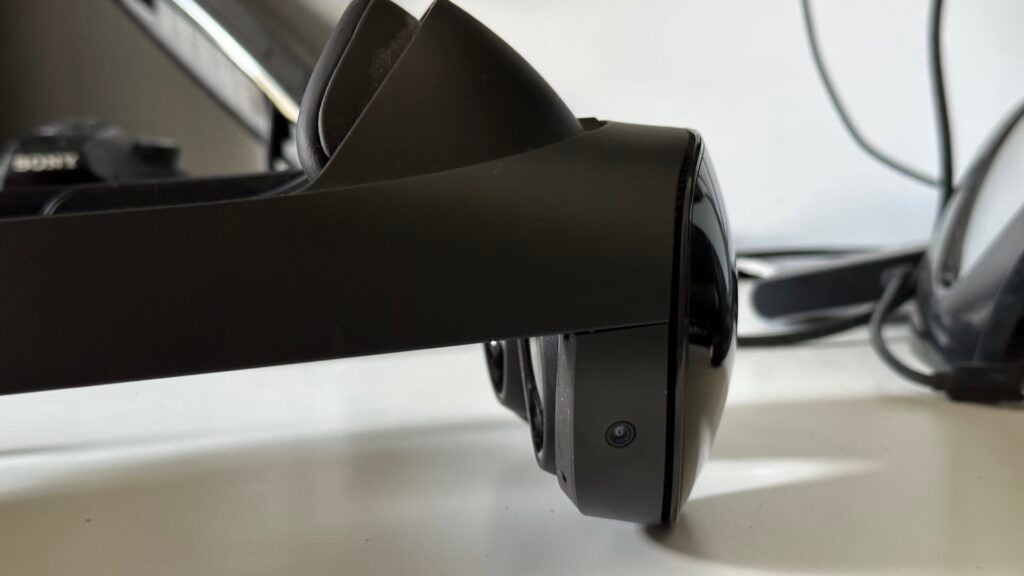
This is made possible thanks to the introduction of a new Fresnel-based lens system and the fact that Meta has shifted the placement of the battery from the HMD to the rear of the headset. The latter also helps with weight distribution, which is of key importance to the Meta Quest Pro as it’s much heavier than its cheaper sibling at 772g.
The slimline HMD is connected to a rigid head strap with a crank adjustment similar to that of the Quest 2’s optional Elite Strap, making it relatively easy to slip the headset on and tighten it in place – easier than messing around with the material straps of the Quest 2, anyway.
Within the strap you’ll find embedded stereo speakers that do a surprisingly good job at providing spatial audio. They won’t block noise from your environment so it’s not great if you want to play a bit of VR in a loud environment, however, nor does it provide the same booming bass when playing my favourite tracks on Beat Saber. But, if you want full audio immersion, you can hook up some good-old wired headphones with the inclusion of a 3.5mm headphone jack.
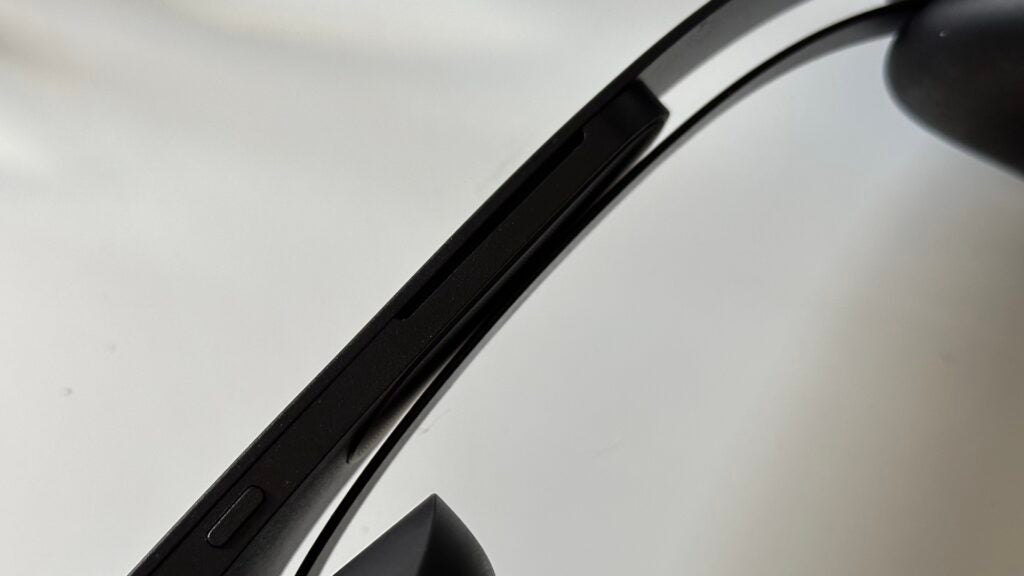
Getting the exact fit can be a bit of a fiddly job, especially at first as the headset doesn’t attach to your face like the Quest 2, but rather floats just in front of your eyes. There is a fit checker that uses the face- and eye-tracking of the headset to confirm that you’re wearing the headset correctly, but it’s not always the most helpful or accurate. Still, it should make it a little easier to introduce friends and family to the world of VR and make sure they’re getting the best experience possible.
That’s also true of the IPD (inter-pupillary distance) adjustment of 55-75mm, offering a wider range than the Quest 2’s 56-70mm, and it’s much more granular than the three preset adjustments from the entry-level headset too. This all makes it much easier to get crisp visuals from the headset, though, unlike the competing HTC Vive Elite XR, you’ll still have to move the lenses yourself.
I should also point out that the Meta Quest Pro doesn’t come with a full light blocker in the box, instead shipping with side blockers that help reduce the distraction of the real world while still being aware of your physical surroundings. That’s down to the AR/VR capabilities of the headset, which I’ll come to a little later on.
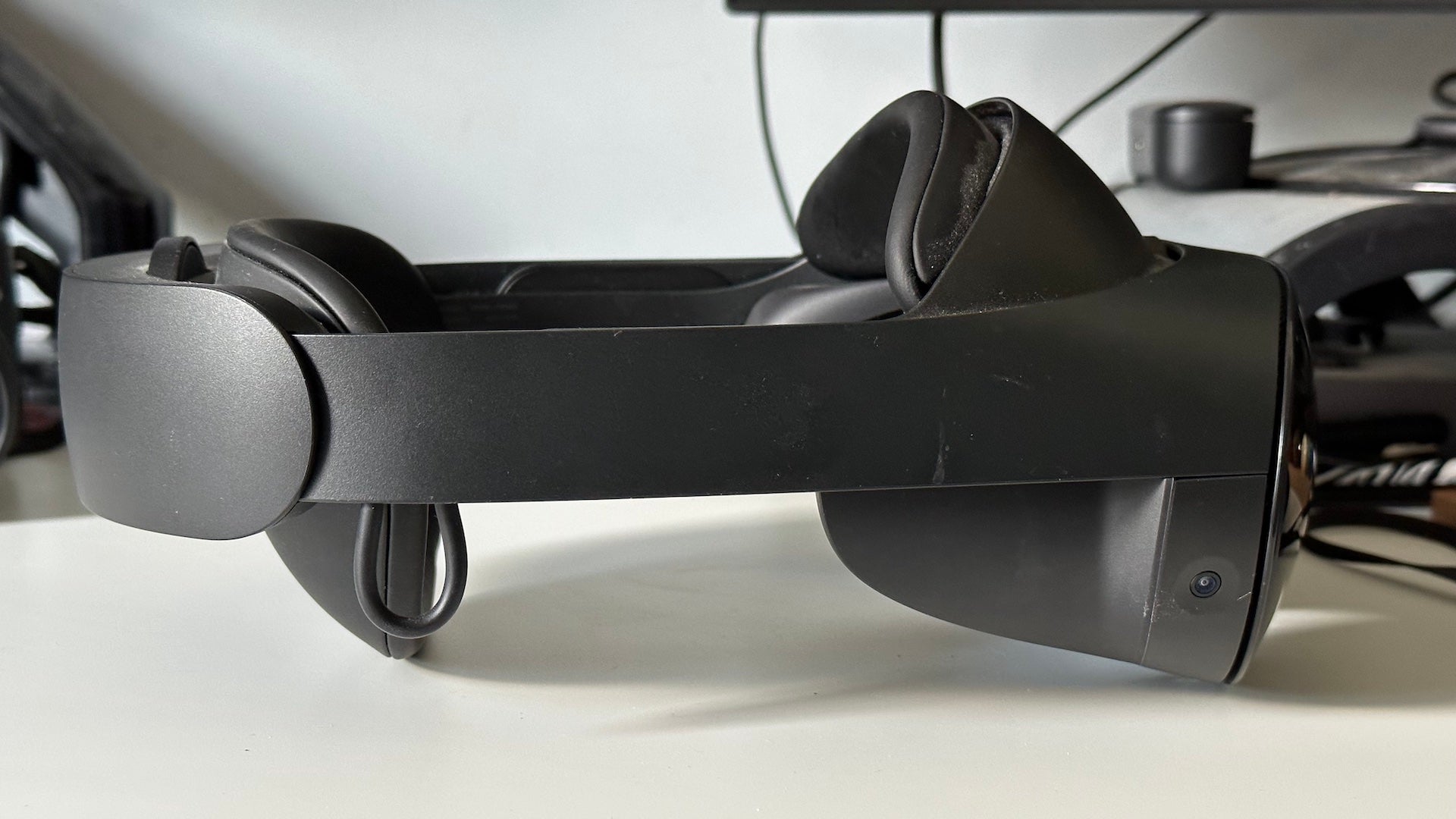
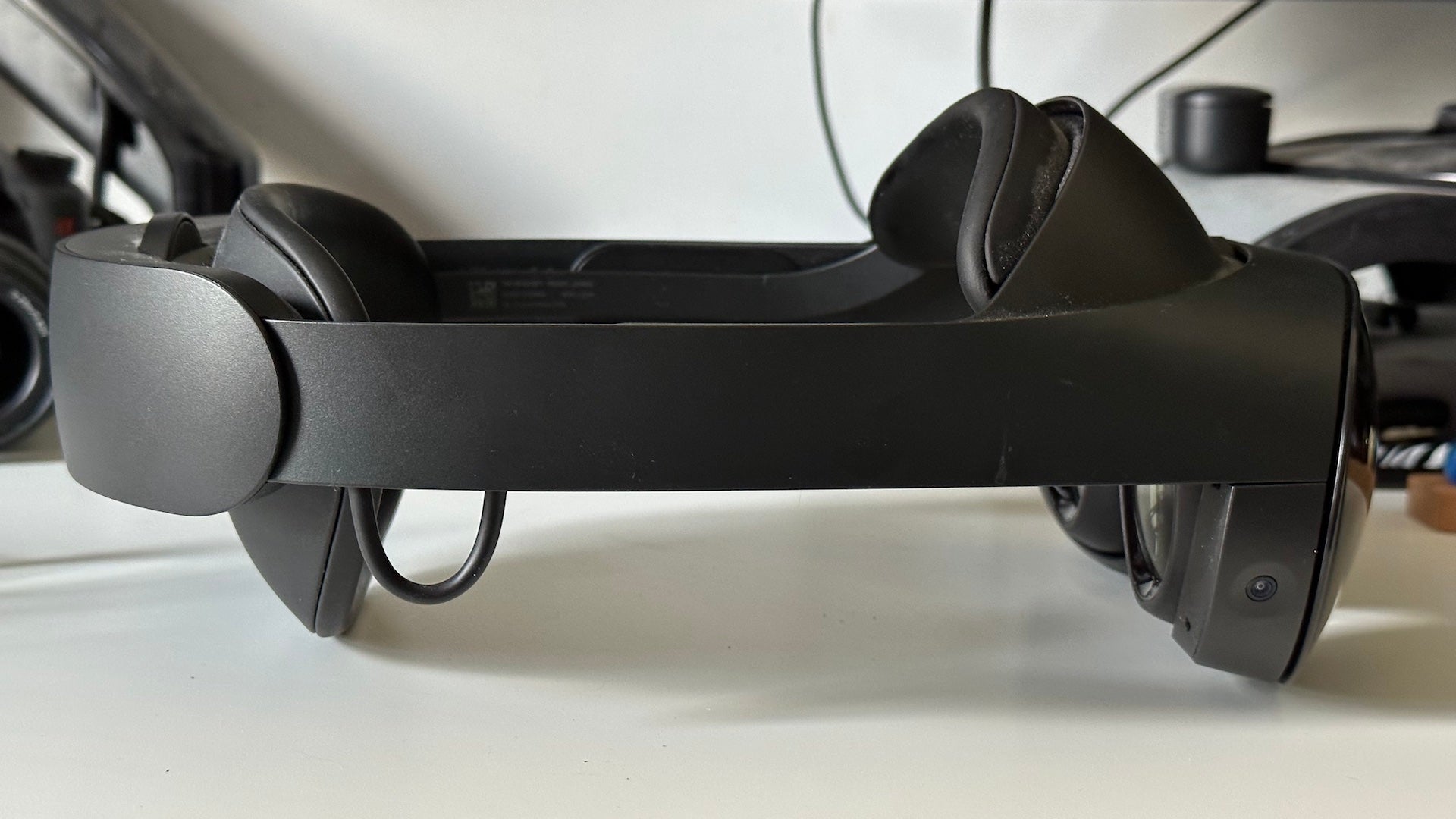
Meta does offer a traditional full light blocker, which uses magnets to snap into place pretty easily, but it’ll cost you an additional £49.99 – a hefty price considering the premium price tag of the headset. It would’ve been much more beneficial to include both the side blockers and full blockers in the box to allow for the best possible implementation of AR and VR without needing to fork out for additional accessories, but hey…
Controllers
- New Quest Pro controllers
- Much smaller and more compact
- Able to track position independently of headset
The Meta Quest Pro comes with completely redesigned controllers that are much more compact and lightweight than those that ship with the Quest 2. You might notice that the tracking ring of the older controllers is no longer present, and that’s because the controllers no longer rely on the headset for tracking – they’re capable of doing that all by themselves.
This is thanks to the addition of a smattering of cameras across the controllers that, when combined with the Snapdragon 662 chipset found in each controller, can compute its position with the same 1:1 accuracy you’ve come to expect from Meta’s controllers.
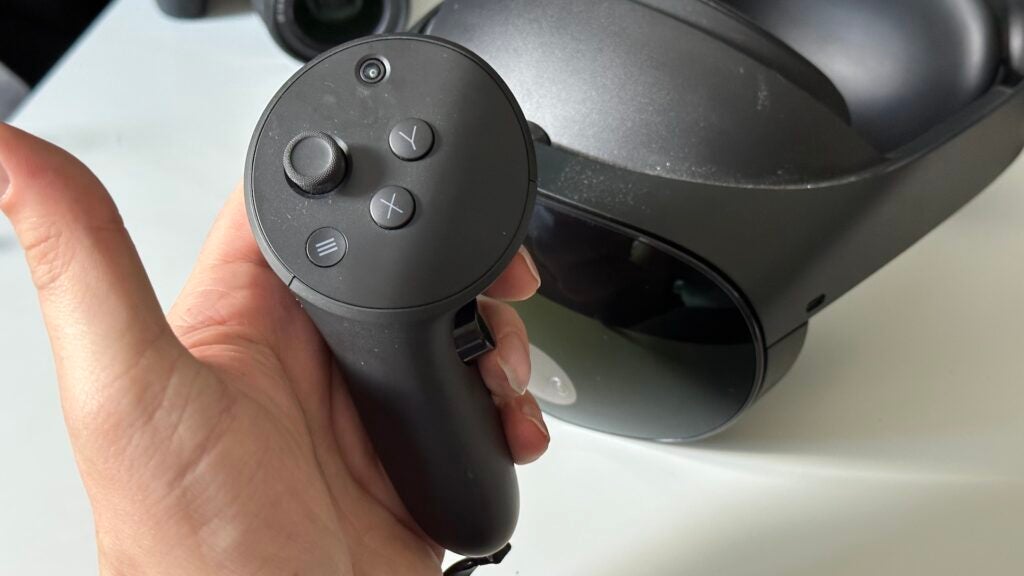
It means that there aren’t any dead spots when tracking, regardless of the controllers’ position compared to the headset. That’s a huge boon in VR games like Blade and Sorcery: Nomad where you have to reach behind your shoulder to retrieve weapons. Making such moves with the Quest 2 would occasionally result in lost tracking, but that’s not something I really experience with the Pro controllers.
The Pro controllers are my favourite among all VR headsets available at the moment, especially compared to the relatively chunky controllers on offer from the equally high-end HTC Vive Elite XR.
The compact form factor allows the controllers to fit much more comfortably in my hands, making it easier to grip, while still allowing for easy access to all the buttons and triggers. There’s even a new slanted area for resting my thumbs when not in active use, a feature particularly helpful for boxing games where you tend to make a fist around your controllers.
The button placement hasn’t changed compared to the Quest 2 so there’s very little adjustment if you’re coming from Meta’s cheaper headset, and it also allows for backward compatibility with the older headset – though at £300/$300, I’m not sure many will invest.
Specs and features
- Greatly improved visuals from pancake optics
- Top-end performance from Snapdragon XR2+ Gen 1
- Face- and eye-tracking tech
The Meta Quest Pro offers greatly improved visuals, but what might be surprising is that it’s not down to an increase in resolution, with the Pro sporting a similar 1800 x 1920 per eye resolution as the Quest 2.
Instead, it’s down to the new pancake optics that deliver a notable improvement on overall image fidelity, allowing it to look much clearer and more vibrant overall – though that’s likely also helped by the Mini-LED backlighting that boosts the dynamic range on offer.
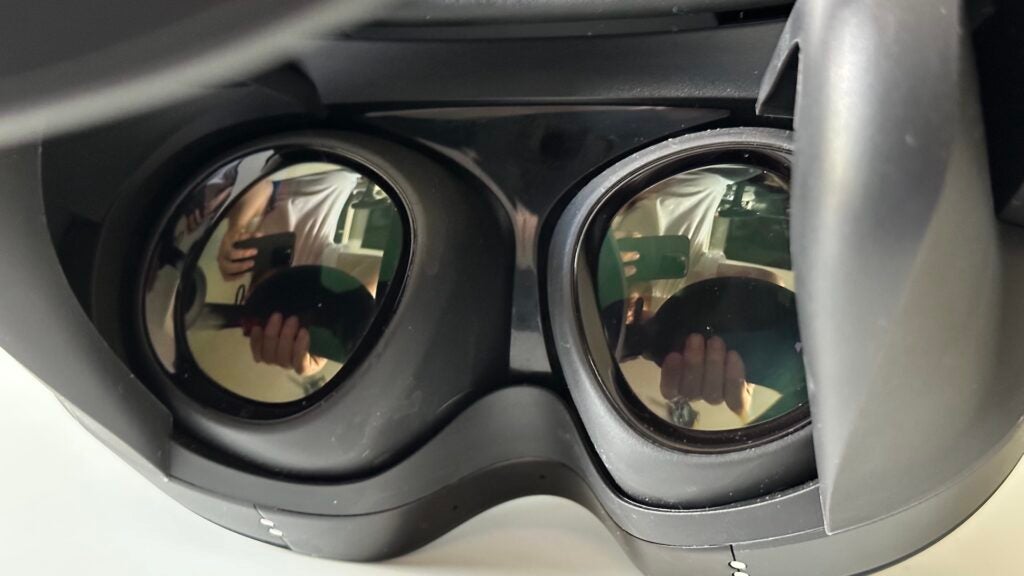
The combination of improved optics and a (fairly) high-res display also makes it easier to read text in VR, one of the big hurdles of earlier headsets that suffered from SDE (screen door effect) – a particular boon for working in VR which, funnily enough, the Quest Pro is designed for.
It’s worth noting that the pancake optics aren’t exclusive to the high-end headset. In fact, the Quest 2 competitor, the Pico 4, boasts both a pancake lens system and higher resolution displays (2160 x 2160 per eye) than the Quest Pro, and it costs just £379 in the UK.
One area where the Meta Quest Pro is a significant improvement on the Quest 2 is in the processing department, sporting Qualcomm’s updated Snapdragon XR2+ Gen 1 chipset and a decent 12GB of RAM to play with. Meta claims that there’s a 50% boost to processing power and 30% improvement to thermal performance that keeps it running optimally for longer periods.
The chipset also boosts head, controller and hand tracking, with the latter offering markedly better performance than the already-decent Quest 2. It’s particularly notable in AR games and experiences when combined with the new full-colour passthrough, further breaking down the barriers between the real and virtual worlds, as well as making existing hand-tracked titles like Unplugged: Air Guitar all the more enjoyable to play.
The other big additions to the Meta Quest Pro are face- and eye-tracking sensors that allow the headset to map your gaze and facial expression and use this data in VR apps like Meta’s work-focused Horizon Workrooms to provide a much more lifelike social experience, and it should be a huge boon in social VR apps that support the tech too.
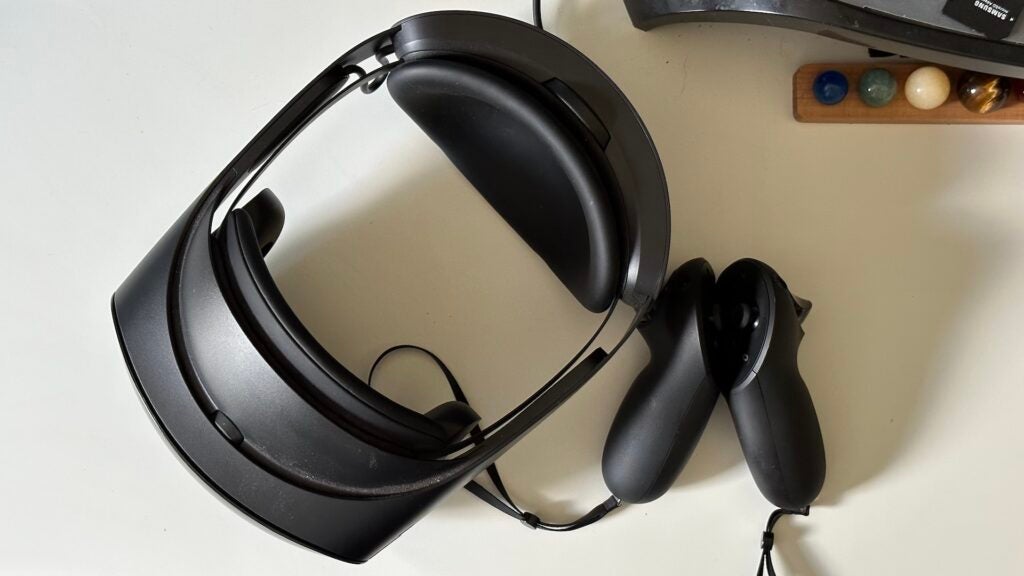
It allows you to better communicate with people in VR and is able to pick up on the smaller nuances in human communication like a cheeky wink or a smirk when saying something sarcastic. That’s great for VR collaboration, helping it feel more natural, lifelike and memorable than staring at an expressionless face for hours on end.
The issue is that it’s not really tech that you’ll benefit from yourself, as those you converse with in VR will also need the Quest Pro and its sensors to properly emulate facial expressions and gaze. Still, it should be appreciated by all your VR mates!

Other notable specs include a boosted 256GB of storage as standard, as well as support for Wi-Fi 6E and Bluetooth 5.2, though it’s worth noting that the headset still can’t be used with standard Bluetooth headphones due to latency issues. Instead, it’s used to connect to your smartphone to deliver incoming notifications on-screen while using the headset.
Battery life could be better at a rated 90-120 minutes of use depending on what you’re doing, and that seemed about right in my months of using the headset for AR and VR. You can extend the battery life to match the 3 hours of the Quest 2 by disabling face and eye tracking, but that kind of defeats the purpose of the headset.
At least charging is convenient via the bundled dock; simply place the headset and controllers onto the black low-profile dock to charge them up.
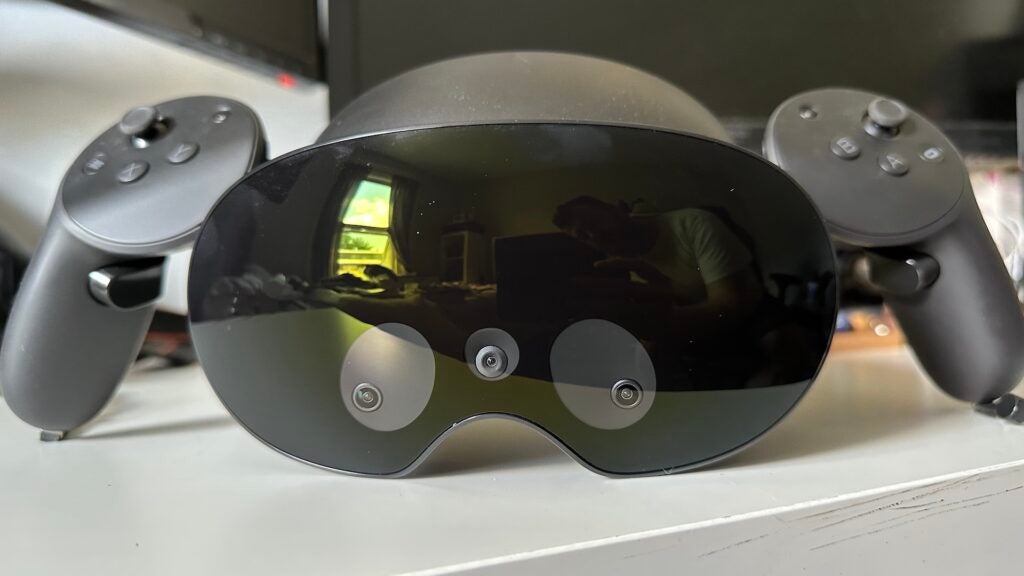
Performance and software
- AR experience is cool but it lacks apps
- VR is just as fun as it is on the Quest 2
- Side blockers let in light from below the headset
Meta’s vast library of VR experiences is one of the biggest draws of any Meta headset, boasting high-quality exclusive titles like The Climb and Robo Recall as well as hugely popular virtual games like Beat Saber. However, the Meta Quest Pro isn’t just focused on VR – it also has its sights set on blending the real and virtual worlds using augmented reality (AR).
That’s powered by front-facing full-colour cameras that – in addition to delivering colour instead of black-and-white passthrough like the Quest 2 – boasts 4x the pixels. It’s also stereo passthrough compared to the mono offering from the cheaper Pico 4, which combines the input from the two front-facing cameras to provide a sense of depth when looking at your environment.
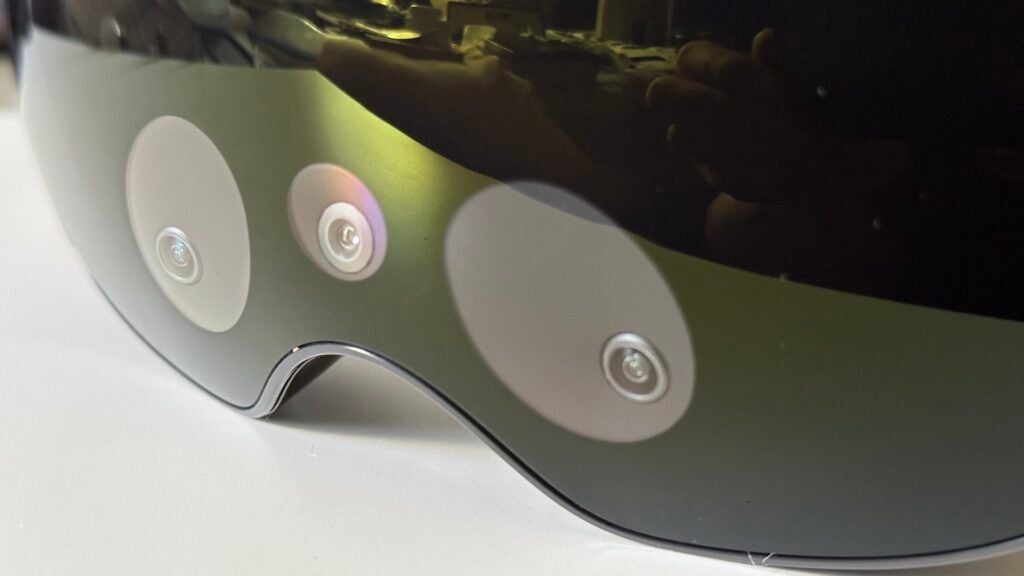
It’s still not perfect – the stereo passthrough creates a bit of warping in places where it tries to blend the two inputs together – but it’s not enough of an issue to detract from the overall experience, especially once virtual elements are overlaid on top of the camera input.
You’ll also have to manually set up your room and ‘tell’ the headset where various walls and surfaces are before the AR fun can begin, but the company claims it’s working on an automatic solution for release further down the road.
Augmented reality apps and games like I Expect You To Die: Home Sweet Home feel so comfortable thanks to the open periphery design of the headset that essentially allows you to see the real world in your peripheral vision, helping you stay grounded while experiencing AR fun. That explains the lack of a full-light blocker like most traditional headsets.
The big problem is that there aren’t a lot of AR-themed apps available to download, even 8 months after the headset was first released. You’ve got a few notable options like Virtuoso, but most, like Horizon Workrooms and Gravity Sketch, are focused on VR collaboration and work.
And, with the Meta Quest Pro being such a niche option thanks to its premium price, I’m not sure many developers will go all-in on developing AR apps – not until the release of the cheaper Quest 3 later this year, anyway.
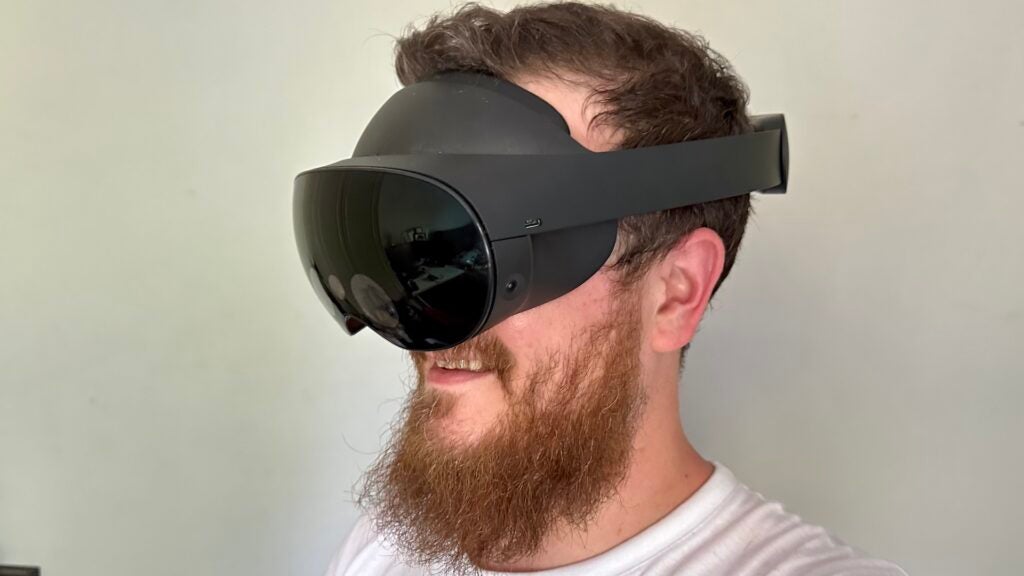
To be fair to Meta, the Workrooms update was a pretty cool one, essentially giving you your own private virtual (and customisable) office with access to your PC or Mac display. Or, if you prefer, you can use it in passthrough mode and see your real environment with up to three floating displays in front of you, anchored in place.
It’s handy if you’ve only got a compact workspace and want to use a multi-display setup, though I gave up trying to use a headset for work after around 3 hours of use – it was just too uncomfortable to wear for such long periods. As such, I’d taper expectations about ditching traditional laptop displays for the Meta Quest Pro, as tempting as it may be.
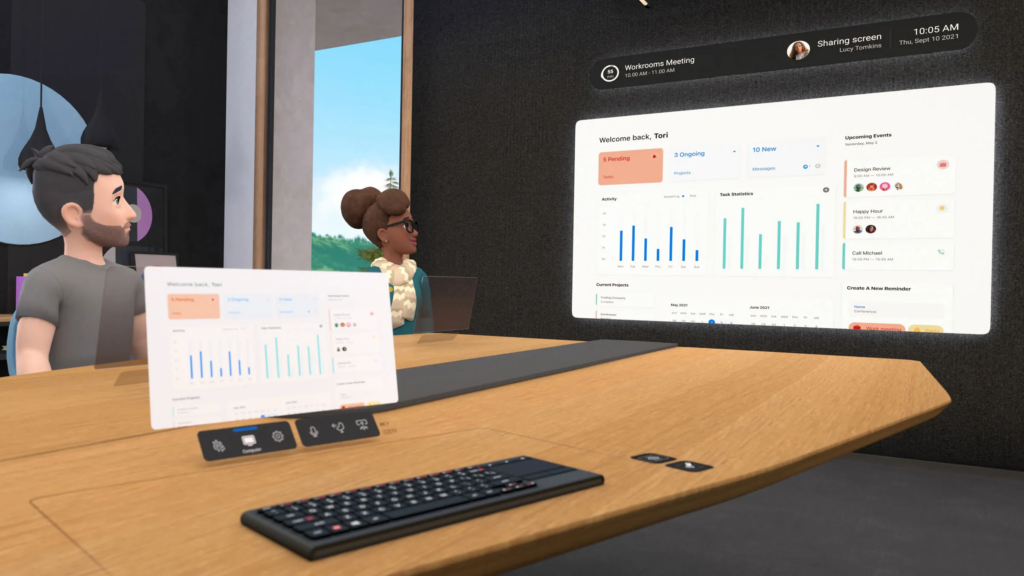
When it comes to traditional VR apps and games, expect a very similar experience to the Quest 2 – though with slightly improved visuals – which is to say that it’s top-tier and thoroughly enjoyable. You’re also able to use Air Link, Meta’s wireless PC connectivity tech, to stream VR titles from your gaming PC to further expand the VR offering.
My only VR-related complaint is that the standard side-blockers provided in the box with the Meta Quest Pro let light in from the bottom of the headset, occasionally distracting me from the virtual world and stopping me from being completely immersed. For that, you’ll have to purchase the optional full-light blocker I mentioned earlier.
Latest deals
Should you buy it?
You love the idea of face- and eye-tracking:
While colour AR passthrough is confirmed to be headed to the Quest 3 later this year, it looks like face- and eye-tracking will remain exclusive to the Pro. It’s great for social VR, providing a more natural human experience.
You just want a VR headset:
While VR is available on the Quest Pro, the lack of a full light blocker in the box means it’s not as immersive as the Quest 2. Plus, the VR games are identical across the two, so you’re not gaining anything by opting for the top-end headset.
Final Thoughts
The Meta Quest Pro is a pricey headset that isn’t for everyone – especially now that Meta is teasing the Quest 3 and its colour AR capabilities ahead of release this year at half the price of the £999/$999 Quest Pro.
That’s not to say that it isn’t impressive, with the headset’s face and eye tracking offering a real benefit to social VR interactions, and the pancake optics really improving overall clarity without having to boost the display resolution too much. It’s also a sleek bit of kit, even if it does get uncomfortable after a couple of hours of constant use.
The Quest Pro controllers are a real treat too, offering not only a much more compact form factor than the Quest 2 controllers but the ability to track themselves in the physical space without needing the headset to pinpoint their location. This completely eliminates dead spots and the occasional loss of tracking, as well as being more comfortable to hold and use.
However, with a price tag literally double that of the upcoming Quest 3 and the lack of killer AR apps to really sell the advanced features on offer, it remains a hard sell for anyone aside from those that really want to try AR right now. For most people, the Quest 2 remains the best option around. Check out our Best VR headsets for more options.
How we test
When testing a VR headset, we make sure to try out a variety of games and apps. We evaluate various aspects, such as the design, fit, screen quality, battery life and the feature set.
Tested a variety of AR and VR titles
Used games and apps to benchmark performance
FAQs
Yes, you can use the Quest Pro controllers with the Quest 2 to improve the tracking capabilities in games and apps.
It comes with 256GB of storage as standard, with no other storage options available.
Usually between 1.5 and 2 hours depending on the app/game in question, though that can be extended by disabling the face- and eye-tracking when not in use.

